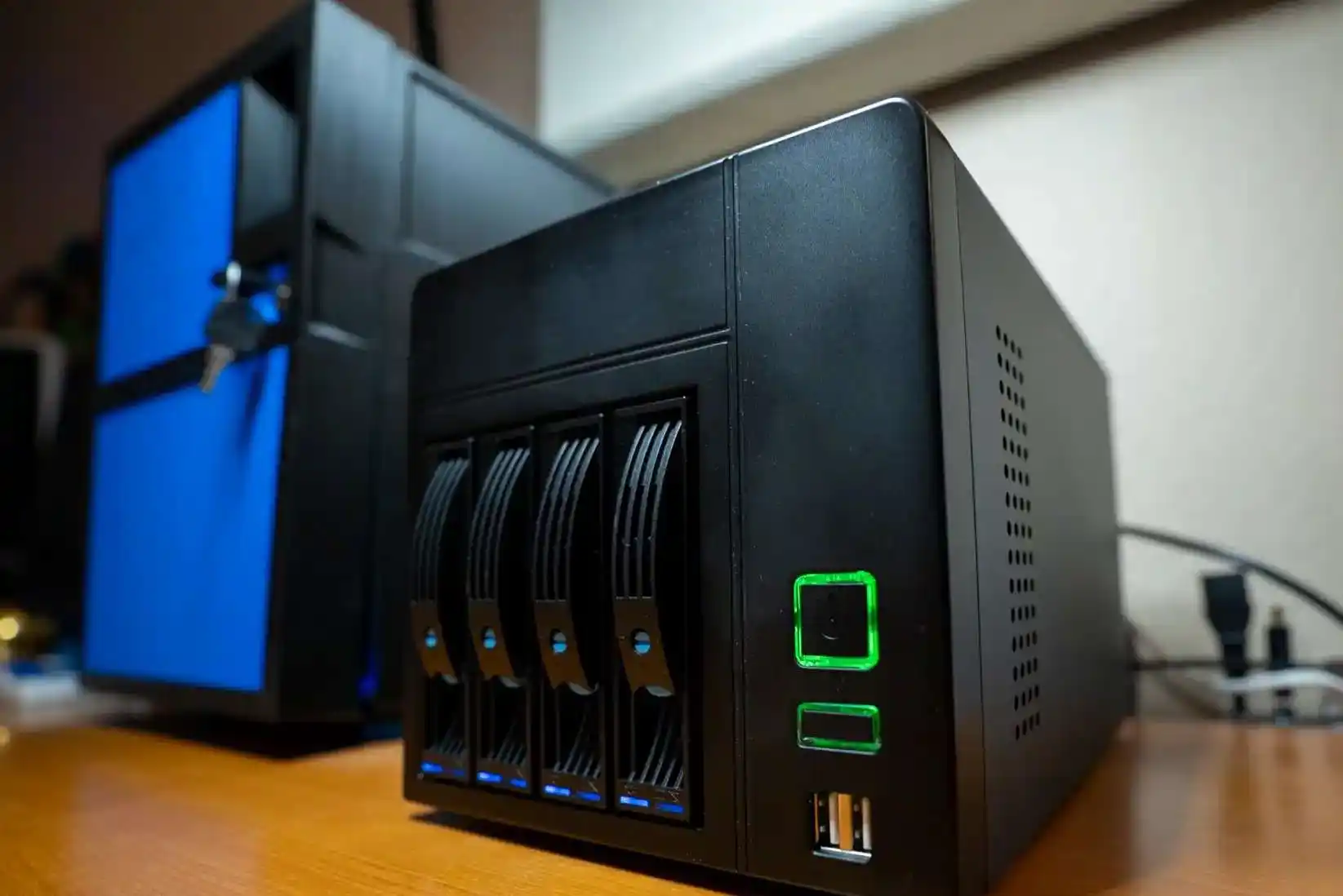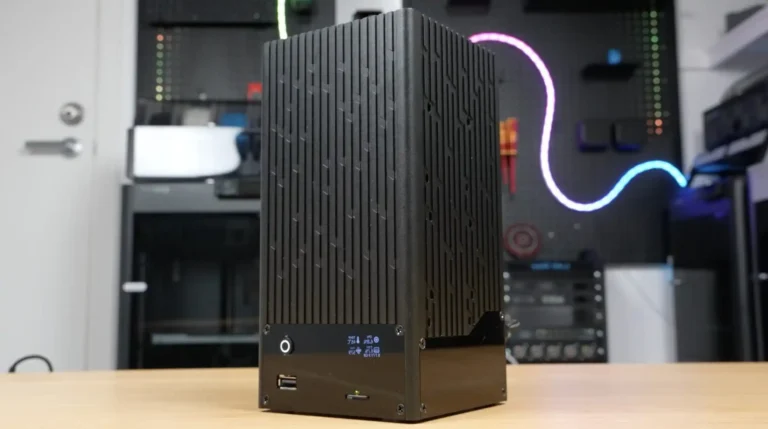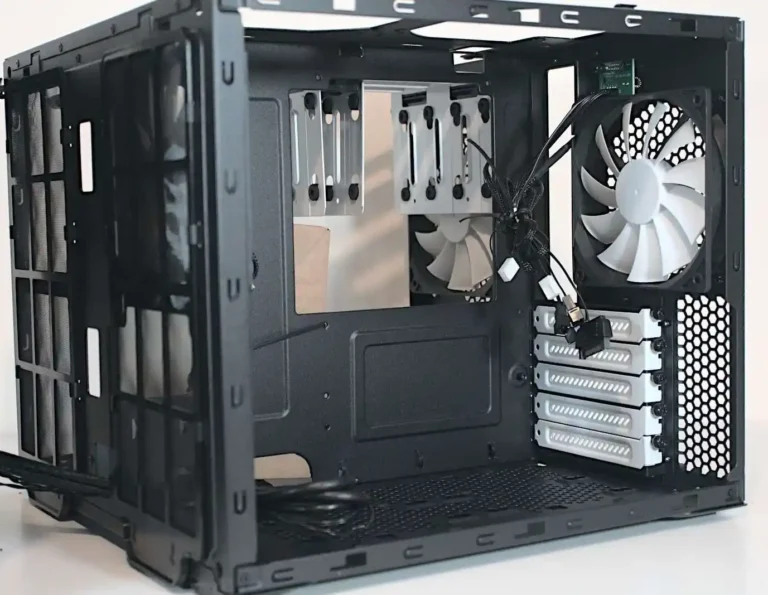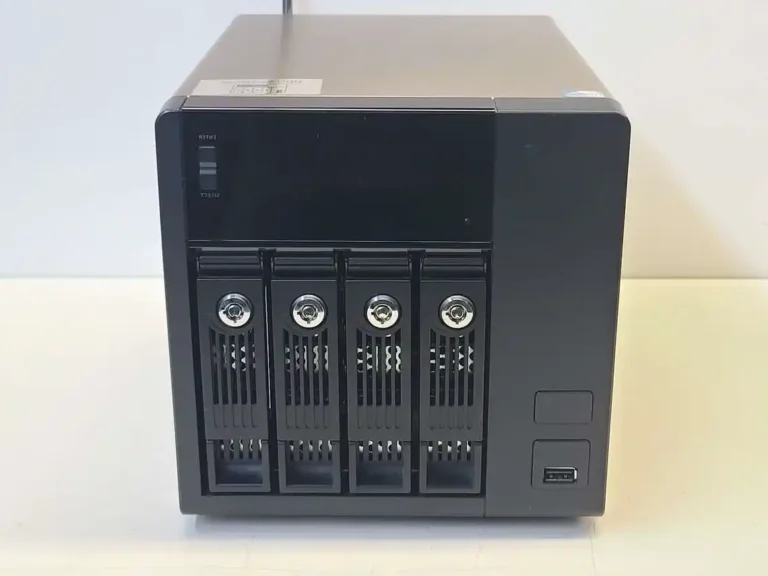ディスクを取り回し、レーンを供給し、不安定なケーブル配線のための時間はありません。この本は、「NASシャーシ+HBA+エキスパンダ」という面倒なパズルを、現場ですぐに使えるチェックリストに変えてくれる。おしゃべり好きで、ちょっとクズで、実際にラックで壊れたり飛んだりするものに焦点を当てている。.
TL;DR:プロトコルの世代をエンド・ツー・エンドで一致させること、バックプレーンのタイプを知ること、SATAをマルチパスしないこと、ベイだけでなくアップリンクのサイズを決めること、HBAを冷やすこと。疑問がある場合は、SAS3とITモードを指定します。.
SAS3 HBA (LSI/Broadcom 9300/9305/9400) vs SAS2
初日からボトルネックにならないHBAを選びましょう。SAS3(12Gb/秒)カード(9300/9305/9400ファミリー)は、最新のバックプレーンやエクスパンダと良好に動作します。SAS2は確かに動作しますが、古く、遅く、エクスパンダを積み重ねたり、SATA SSD/HDDを混在させ始めたりする場合に寛容ではありません。ZFSを実行する場合、カードをフラッシュして ITモード そして、ファイルシステムにrawドライブを参照させる。シンプル、安定、予測可能。.
なぜ気にするのか? プロトコルの不一致は、奇妙なリンク切れや謎のタイムアウトにつながるからだ。また、未来の自分はさらにドライブを追加するだろう。いつもそうなる。.
バックプレーン「EL1 vs EL2」とSATAドライブ vs SASドライブ
EL1 = シングルポートのエクスパンダ・バックプレーン。EL2 = デュアルポート。SASドライブはデュアルパスを使用できます(HA / MPIO用)。. SATAはできない このコンテキストでは、デュアルパスを使用します。ですから、同じSATAグループに2つのアップリンクを接続して、魔法のような帯域幅を期待しないでください。余分なスループットではなく、エラーが発生します。SATAでは ひとつ クリーンなパスで退屈させない。SASデュアルポートディスクとEL2バックプレーンでは、適切なマルチパスでワイルドに。.
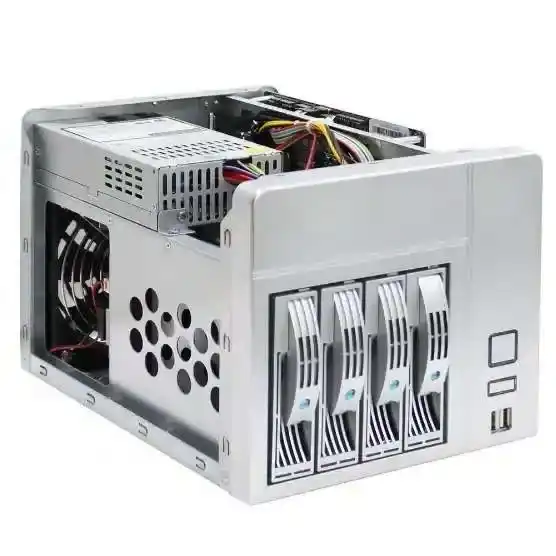
SASエクスパンダ(インテルクラス、HPクラス):役に立つとき、困るとき
エクスパンダは高密度化には最適です:多くのベイ、少ないHBAポート。しかし、すべてのエクスパンダはホップを追加します。 アップリンクレーン が本当の天井です。アレイが激しくバーストする場合、スクラッブ、リシルバー、マルチクライアントの読み取りを行う場合、各エキスパンダがHBAに戻る十分なアップリンク帯域幅を持っていることを確認してください。そうしないと、きれいなLEDで渋滞を作ることになります。.
経験則だ: アップリンクをベイで拡張する。より多くのディスク⇒より多くのアップリンク(バックプレーンがそれをサポートする場所)。.
SFF-8087/SFF-8643/SFF-8654(SlimSAS):ケーブル工場に合わせてください。
コネクタのアルファベットスープは重要だ。.
- SFF-8087クラシックな内蔵ミニSAS(SAS2時代)。.
- SFF-8643ミニSAS HD (SAS3)。.
- SFF-8654(スリムSAS)24Gギアにも搭載されている。.
を使用する。 右 ケーブルや適切なファンアウトハーネスを使用してください。シグナルインテグリティは雰囲気ではなく、物理的なものです。信号の完全性は雰囲気ではなく、物理的なものです。.
帯域幅、アップリンク、オーバーサブスクリプション
x4アップリンク1基の24ベイ・シェルフでは、スクラブ+バックアップ+VMブートでクロールすることになる。バックプレーンで可能なら、複数のアップストリームポートにベイを分散させる。あなたの 応募倍率 (1つのアップストリームを共有するダウンストリームレーンの数)。アップリンクを追加できない場合は、ワークロードの時間をずらすか、リビルドの同時実行数に上限を設定する。.
ZFS/TrueNAS、ITモード、ドライバに関するメモ (mpt3sas)
でHBAを実行する。 ITモード そのため、ZFS/TrueNASはディスクを直接管理できる(RAID BIOSのいたずらなし)。Linuxでは mpt3sas ドライバは、ほとんどの SAS3 HBA をバックアップします。OSとHBAファームウェアを最新に保つ。古いSAS2カードは動作しますが、ドライバ・サポートと癖はSATA/SAS混在負荷下でより早く現れます。.
冷却と電力:あなたを救う退屈なもの
HBAとエキスパンダは熱を捨てる。HBAとエキスパンダは熱を捨てます。 エア・トンネル, 暖かい風ではありません。シャーシがぎゅうぎゅう詰めの場合は、小型の静圧ファンウォールを追加してください。エキスパンダーの電源(モレックスまたはスロット電源)を確保し、スピンアップでたるむデイジーチェーンスプリッターを避ける。熱対策が第一で、きれいなケーブル配線は第二です。.
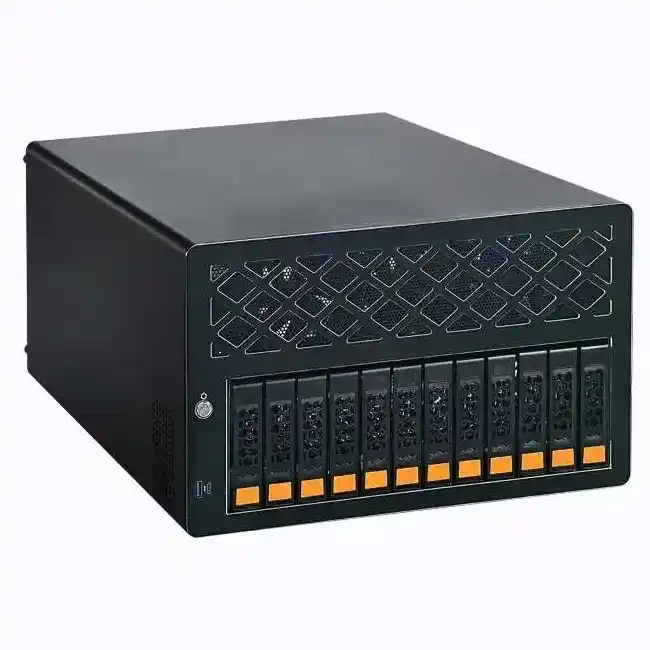
互換性チェックリスト(プリントミー表)
| 項目 | チェック項目 | 良い兆候 | 備考 |
|---|---|---|---|
| HBAの世代とモード | カードモデル、ファームウェア、IT vs IR | のSAS3(9300/9305/9400)。 ITモード | RAID BIOSとZFSの混在は避けてください。. |
| バックプレーンタイプ | EL1 / EL2 マーキングまたはマニュアル | SATAシングルパス用EL1、SASデュアルパス用EL2 | SATAをデュアルパスしないでください。. |
| エキスパンダーの存在感 | バックプレーンまたは別ボード上のモデル | 最新のFWを搭載した既知のSAS2/3エクスパンダ | ベイを増やす?キャディだけでなく、アップリンクも追加する。. |
| アップリンク数と速度 | バックプレーン/エクスパンダからHBAまで#のx4リンク | ≥16-24ベイの高負荷に対応する2つのアップリンク | スクラブ中のオーバーサブスクリプションを減らす。. |
| ケーブル&コネクター | SFF-8087/8643/8654マッチ | 正しい仕様のケーブル、短い配線 | 両端にラベルを貼る。. |
| SATAとSASのミックス | グループごとのディスクタイプ | SATAグループをシングルパスに保つ | MPIOが必要な場合は、SASデュアルポートを使用する。. |
| OSとドライバー | カーネル+(プラス mpt3sas / プラットフォームノート | 現在のOS/HBA FW、既知の良好なペアリング | ピンのバージョン. |
| 冷却と電力 | HBA/エクスパンダ上のエアフロー、安定した電力 | 前後流、ホットポケットなし | ケーブルを縛り、スピンアップ時のたるみを防ぐ。. |
3つの簡単なシナリオ(実戦的な雰囲気)
小さなホームラボ、8ベイNAS(静かなサイドオフィス)
を選ぶ。 ITXボード コンパクトな筐体ITモードでSAS3 HBAを1基搭載。EL1バックプレーン1基、アップリンク1基、SATA HDDミックス。シンプルに、クールに。整然としたフットプリント、コンパクトな ITXケース は素晴らしく機能し、薄型HBAのためのスペースもまだ残っている。.
SMBファイルサーバー、24ベイ、HDD混在+SATA SSDキャッシュ数台
ここで ラックマウント が賢明な選択だ。まだデュアルパスしないとしても、EL2バックプレーンを目指してください。追加 2つのアップリンク エクスパンダからHBAへ。バックプレーンポートごとにvdevをマッピングし、負荷を分散します。強固な サーバーラックPCケース (4U)にファンウォールを搭載することで、HBAとエクスパンダを幸せに保ちます。.
メディア+VMラボ、バースト・リード、頻繁なスクラビング
あなたは、花火ではなく、予測可能なスループットを望んでいる。SAS3 HBAを使用し、バックプレーンのレーンを確認し、プールを以下のように分割します。 に アップリンクエアフローのヘッドルームと余分なスロットが必要なら、広々とした 4Uサーバーケース 窮屈な奥行きの短いシャシーに勝るものはない。.
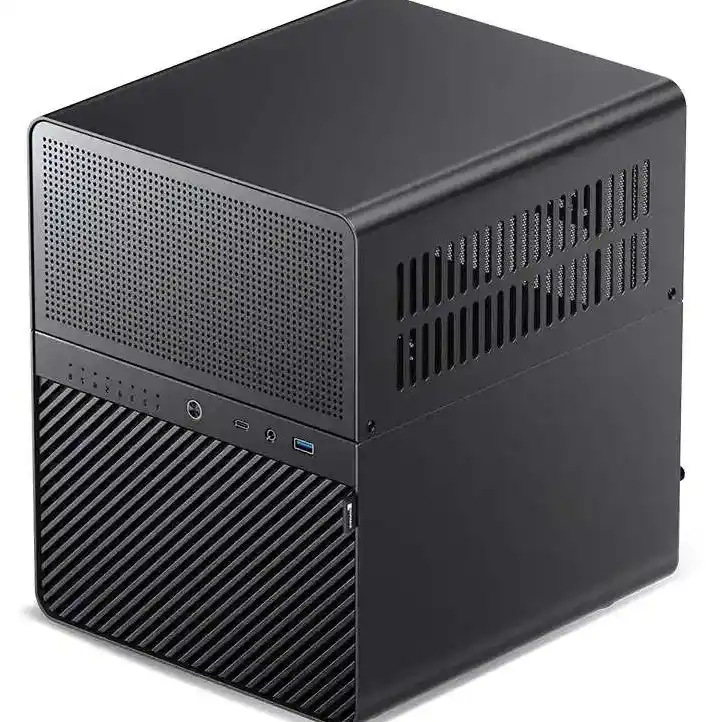
IStoneCase が適合する場所 (そして、なぜサイクルを節約できるのか)
必要なのは箱だけではありません。レーン、エアフロー、実際のメンテナンスのために作られた箱が必要なのです。IStoneCaseは、まさにそこに位置しています。OEM/ODM ダウンタイムを嫌うデータセンター、アルゴリズムチーム、MSP、ビルダーにとって、作業、迅速な微調整、大量ビルドが可能です。もしあなたが サーバーPCケース 適切なファン配置、事前に配線されたバックプレーン配線、HBAとレールのためのスペースがあれば、ここから始めてください:
- GPUサーバーケース - AI/HPCノードで、まだ近くにティア2/3のストレージが必要な場合。.
- サーバーケース - 汎用、ATX/E-ATXレイアウト、ホットスワップフロント。.
- ラックマウントケース - あなたのクラシック コンピューターケースサーバー ラック内で、ケーブルに優しい。.
- NASケース - クリーンベイ、適切なエアフロー、HBAルーム。.
- ITXケース - 小さいが、薄っぺらくはない。.
- シャーシガイドレール - レールをスキップしてはならない。サービス性とは稼働時間である。.
- サーバーケースOEM/ODM - あなたがスペックを持ってくれば、彼らは図面、プロト、そしてランを持ってくる。.
SEO担当者:これは、人々が実際に検索するフレーズにも対応しています。サーバーラックPCケース, サーバーPCケース, コンピューターケースサーバー, atxサーバーケース-詰め込みも誇大広告もない。私たちは自然体でいます。.
盗めるノートを作る
- SAS3をエンド・ツー・エンドで開始します。バックプレーンとエクスパンダーの動作が改善され、後で再塗装する必要がなくなります。.
- アップリンクは金のように扱え。早めに追加しましょう。オーバーサブスクリプションは無料ではありません。.
- SATA = シングルパス。SAS=デュアルパス。これを混同すると、「なぜSSDが消えてしまうんだ?.
- HBAのシンクをエアフロー内に保つ。カードが死角になっている場合は、直接ファンを追加する。小さな修正で大きな勝利。.
- ラベルケーブル。将来、暑い通路でトーンプローブしている暇はない。.
- ストレス下でのテスト。スクラブ、再シルバー、rsyncの嵐。それを乗り切れば、おそらく問題ない。.
ミニFAQ
1つのSATAバックプレーン・グループから1つのHBAに2本のケーブルを接続して、速度を上げることはできますか?
いや。そのような仕組みではありません。帯域幅ではなく、エラーが表示される可能性が高い。.
エキスパンダーは必要ですか?
ポート数対ベイ数が必要な場合のみ。その場合は、アップリンクに注意すること。.
ATXボードは4Uにうまく収まりますか?
一般的にはそうです。ただ、スタンドオフパターンとPCIeスロットのクリアランスを、適切な atxサーバーケース.
そこにNVMeを放り込んでもいいですか?
別の話(U.2/U.3、PCIeスイッチ、JBOF)。このチェックリストでは、我々はSAS/SATAの土地にいる。.

